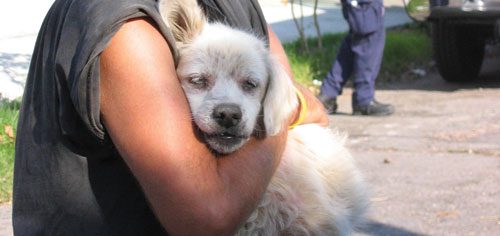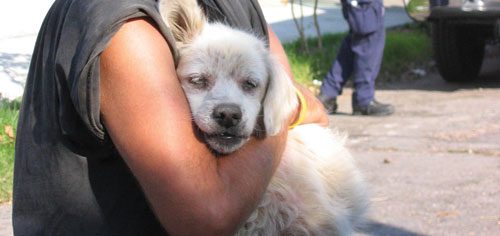

The Dogs of Hurricane Katrina
Medicine For The Mind
In the aftermath of Hurricane Katrina, with virtually all of the humans who actually wanted to leave the city of New Orleans either rescued or evacuated, we began to see pictures of other victims of the disaster. Television screens now carried images of dogs stranded on rooftops. One video clip showed a dog swimming through the foul water desperately trying to reach a rescue boat after its owners were forced to abandon him. Other scenes showed sad starving animals on balconies or staring out of windows. Such mournful sights stirred the emotions of many who saw them and questions began to be asked. In one press conference, Michael Brown, the director of the Federal Emergency Management Agency (FEMA), was asked by a reporter "What about the dogs and cats that have been stranded?" His response began "They are not our concern…"
A short while before Katrina hit, FEMA had gone through a disaster preparedness exercise which involved a mythical hurricane, "Pam," hitting the U.S. Gulf coast. Extensive computer simulations and hands-on practice by search and rescue, police, military and civil authorities, engineers, and medical experts were involved. When Ivor Van Heerden, a hurricane researcher from Louisiana State University who helped direct the simulation exercise, was asked about preparations to save pets, he answered, "They were not part of our plans because they are not considered to be important."
The actual disaster that followed would prove such planners to be wrong. Many people who live with animals consider them important enough to risk their own personal safety to keep their pets from harm. The rescue planners had forgotten that saving the human body is not enough. People need affection, comfort, family (or something that serves as family), as well as a feeling of being needed. These emotional needs often must be met before people can motivate themselves to try to survive physically. For many people, such requirements are filled by the companionship of an animal. Pets are part of their family, and such people would no sooner think of abandoning them than abandoning a child. One exhausted National Guard officer explained to General Russel Honore, who was coordinating the rescue efforts, "We estimate that 30 to 40 percent of the people who refuse to leave the affected areas are staying because they want to take care of their pets."
In the early days of the rescue effort, some authorities showed an incredible degree of callousness. Since no planning had been done to take care of pets, people were simply ordered to abandon them. A heart-rending example involved one young boy among the thousands who ended up sheltered at the Superdome. When he tried to board a bus to Houston while carrying a small white dog, a police officer snatched the dog from the boy. This little animal would not have taken away any space needed by a human survivor. As it was carried away, the boy sobbed "Snowball! Snowball!" then, overcome with his distress, he sank to his knees and vomited. One woman, with no other possessions left, offered her rescuer the wedding ring off her finger to save her dog, but to no avail. There were even stories of local authorities in St. Bernard Parish, who, rather than arguing with survivors about saving their dogs, simply shot their pets.
Some rescuers, however, found room in their hearts for compassion and some means of helping. Many of the National Guard personnel left water and food for stranded dogs in the hopes that they would survive long enough to be saved. Louisiana State Treasurer John Kennedy was helping people board buses near Baton Rouge and found himself intervening when some evacuees resisted because they had been ordered to leave their pets behind. One woman pleaded, "I’ve lost my house, my job, my car, and I am not turning my dog loose to starve."
Kennedy joined other volunteers in taking down the names of those leaving on the buses and asked the Louisiana SPCA to come out and collect the animals. Soon it became standard practice for representatives of the Humane Society of the United States and the ASPCA to meet people brought in from the flood, taking their animals to shelter while recording information so that people could later be united with their pets.
Shortly after leaving the bus loading area, Kennedy found a mixed-breed dog tethered near the road with a unopened can of dog food next to him. With the dog was a plaintive note that read, "Please take care of my dog, his name is Chucky." Kennedy said "What else could I do? I am taking care of Chucky."
There are many stories of disaster victims resorting to extreme measures to save their dogs. Take the case of Dohnn Moret Williams (who likes to be called Moret). His former home is now under water, his possessions are gone, and his elderly father, who also lived in the city, is presumed dead. Still, sitting outside of the Houston Astrodome, Moret’s temporary shelter, there was relief in his face. "I spent most of the morning crying when I knew I could come get him," he said as he reached down to pat Sebastian, a large black Cocker Spaniel with red markings above his brown eyes. Sebastian had just been reclaimed from the Houston SPCA. "I got no children. This here’s my baby."
Their exit from New Orleans was treacherous and exhausting. Surrounded by the polluted, sometimes neck-deep floodwater, Moret knew that the dog would not be able to swim the whole way to safety. So he found an air mattress, and although Sebastian didn’t like it because it tipped when he moved, it gave Moret something that he could tow. Ultimately, they made their way to an elevated portion of Interstate 10 from which people were being evacuated by helicopter. Unfortunately, the rescuers were under orders to prevent pets from boarding.
"There was no way I was leaving without him, and I figured I would do whatever I had to in order to keep him with me," Moret said. "I got a big black trash bag and put Sebastian in it. Then I whispered to him not to make noise."
Surprisingly, the dog seemed to understand. There was, however, one moment when the whole scheme looked as if was going to fall apart. Squeezed up near the front of the helicopter on Moret’s lap, the dog started squirming. Moret said, "He bumped against the pilot, and I thought it was over, but the pilot just goes, ‘I didn’t see nothing.’"
Their subterfuge was not yet done. Moret was given a ride to Houston on a bus that also was under orders not to accept animals. This time, safely seated toward the back of the bus, Sebastian made the whole trip with his nose sticking out the top of the bag. When the two arrived at the Astrodome, volunteer from the SPCA were waiting. Sebastian was only one of many stowaways on the buses. Some dogs were carried in bags or suitcases, and some even hidden under flouncy blouses or stuffed down baggy pants. All were given temporary shelter until their owners reclaimed them. Moret and "his baby" are t gether again and going off to stay with his sister for now.
Sebastian and Moret were lucky. Many other dogs would not make it through this tragedy. Numerous pets were left behind during the initial evacuation of the city. Many of these were left with food and water, since caring owners hoped they would only be away for a few days.
These events point out an important set of guidelines for people who live with pets but are facing an emergency situation. First, at a minimum, each animal should wear identification, such as a small metal cylinder that hooks onto a collar and holds a slip of paper. On the paper you should record the dog’s name, your name, address, telephone number, and email address. A cell phone number or an out-of-town contact is also helpful in case your city or neighborhood is devastated to the degree that local contacts are unreliable.
Secondly, if at all possible, people who share their homes with dogs should never leave them behind in an evacuation. The truth is that you don’t know when you’ll be able to return to your home, and when, or even if, humane agencies will be allowed to rescue your pets-presuming that they survive the initial emergency. Simply put, if you have the means to evacuate, your dogs are safest with you, even if it means you have to camp out. Traveling with your dog in times of crisis may slow your progress, and you may have to make compromises to keep your pet with you.
Fortunately, there are usually people among the rescuers who understand that dogs are not just property to be abandoned like extra baggage. They understand that dogs fulfill an important psychological function and may be a survivor’s only link to affection and the life they used to live.
At one stage in the rescue efforts, an elderly woman was getting ready to board a helicopter to be evacuated out of New Orleans. Against her breast, she hugged a little Yorkshire Terrier. At the door, an enlisted man took the dog and said "Sorry Ma’am, but orders are ‘No animals.’"
The woman’s weary eyes filled with tears, "I got nothing and no one. He’s all I got left!" The soldier stood there holding the dog and repeated "Orders are ‘No animals.’"
At that moment, an officer, wearing captain’s bars and medical corps insignia appeared at the door. His nametag read "Anderson." He reached over to the enlisted man and took the little animal. "That’s not a dog," he said, "that’s medicine."
"Medicine?" asked the puzzled soldier.
"Medicine for the mind," said Captain Anderson, as he handed the dog back to the woman and helped her through the door. ■
To find out how you can help, go to www.moderndogmagazine.com and click on "Help victims of Hurricane Katrina." Dr. Stanley Coren is a professor of psychology at the University of British Columbia and author of many books on dog behaviour, including How to Speak Dog and, most recently, How Dogs Think. His website is www.stanleycoren.com.
Join the newsletter and never miss out on dog content again!
"*" indicates required fields
By clicking the arrow, you agree to our web Terms of Use and Privacy & Cookie Policy. Easy unsubscribe links are provided in every email.